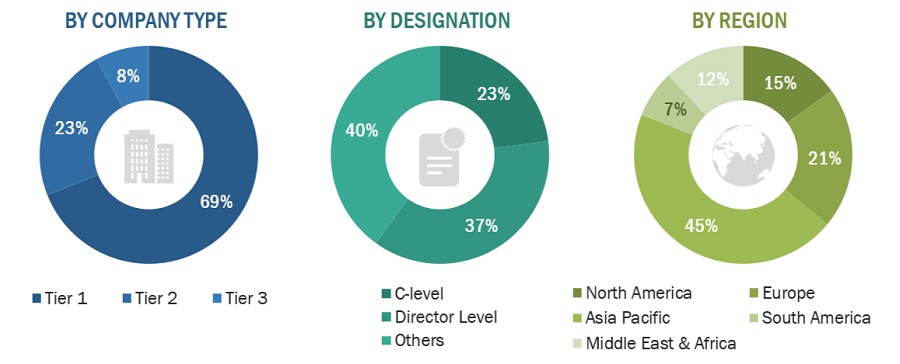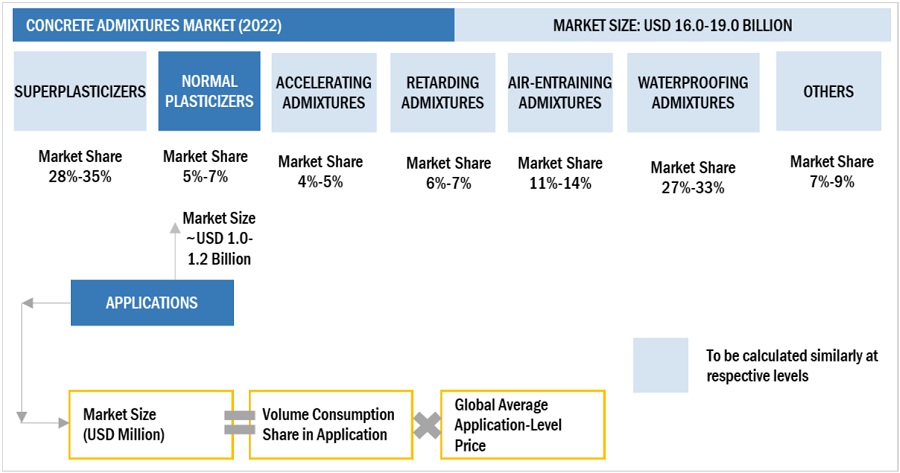The study involved four major activities in estimating the market size for concrete admixtures. Exhaustive secondary research was done to collect information on the market, the peer market, and the parent market. The next step was to validate these findings, assumptions, and sizing with industry experts across the value chain through primary research. Both top-down and bottom-up approaches were employed to estimate the complete market size. After that, the market breakdown and data triangulation procedures were used to estimate the market size of the segments and subsegments.
Secondary Research
Secondary sources used in this study included annual reports, press releases, and investor presentations of companies; white papers; certified publications; articles from recognized authors; and gold standard & silver standard websites such as Factiva, ICIS, Bloomberg, and others. The findings of this study were verified through primary research by conducting extensive interviews with key officials such as CEOs, VPs, directors, and other executives. The breakdown of profiles of the primary interviewees is illustrated in the figure below:
Primary Research
The concrete admixtures market comprises several stakeholders, such as raw material suppliers, end-product manufacturers, and regulatory organizations in the supply chain. The demand side of this market is characterized by superplasticizers, normal plasticizers, accelerating admixtures, retarding admixtures, air-entraining admixtures, waterproofing admixtures, and others. The supply side is characterized by advancements in technology and diverse application industries. Various primary sources from both the supply and demand sides of the market were interviewed to obtain qualitative and quantitative information.
Breakdown Of Primary Participants

Note: Tier 1, Tier 2, and Tier 3 companies are classified based on their market revenue in 2022, available in the public domain, product portfolios, and geographical presence.
Other designations include consultants and sales, marketing, and procurement managers.
To know about the assumptions considered for the study, download the pdf brochure
|
COMPANY NAME
|
DESIGNATION
|
|
Sika AG
|
Senior Manager
|
|
Saint-Gobain S.A.
|
Innovation Manager
|
|
Mapei S.p.A.
|
Vice-President
|
|
RPM International Inc.
|
Production Supervisor
|
|
Fosroc, Inc.
|
Sales Manager
|
Market Size Estimation
Both top-down and bottom-up approaches were used to estimate and validate the total size of the concrete admixtures market. These methods were also used extensively to estimate the size of various subsegments in the market. The research methodology used to estimate the market size includes the following:
-
The key players in the industry have been identified through extensive secondary research.
-
The supply chain of the industry has been determined through primary and secondary research.
-
All percentage shares, splits, and breakdowns have been determined using secondary sources and verified through primary sources.
-
All possible parameters that affect the markets covered in this research study have been accounted for, viewed in extensive detail, verified through primary research, and analyzed to obtain the final quantitative and qualitative data.
Concrete Admixtures Market: Bottom-Up Approach

To know about the assumptions considered for the study, Request for Free Sample Report
Concrete Admixtures Market: Top-Down Approach

Data Triangulation
After arriving at the overall market size—using the market size estimation processes as explained above—the market was split into several segments and subsegments. To complete the overall market engineering process and arrive at the exact statistics of each market segment and subsegment, data triangulation, and market breakdown procedures were employed, wherever applicable. The data was triangulated by studying various factors and trends from both the demand and supply sides in the concrete admixtures industry.
Market Definition
According to Sika AG, concrete admixtures are liquids or powders added to the concrete during mixing in small quantities. Their purpose is to enhance specific properties of fresh or hardened concrete, such as workability, durability, early & final strength, shrinkage control, and others. Different types of admixtures are classified based on their primary function, such as water reducers, superplasticizers, retarders, set accelerators, and more.
Key Stakeholders
-
Concrete admixtures manufacturers
-
Concrete admixtures suppliers
-
Raw material suppliers
-
Service providers
-
Application sector companies
-
Government bodies
Report Objectives
-
To define, describe, and forecast the Concrete admixtures market in terms of value and volume
-
To provide detailed information regarding the drivers, opportunities, restraints, and challenges influencing market growth
-
To estimate and forecast the market size by type, application, and region
-
To forecast the size of the market for five main regions: Asia Pacific, Europe, North America, South America, and the Middle East & Africa, along with their key countries
-
To strategically analyze micromarkets1 with respect to their growth trends, prospects, and contribution to the overall market
-
To analyze opportunities in the market for stakeholders and provide a competitive landscape for market leaders
-
To analyze competitive developments, such as deals and expansions, in the market
-
To analyze the impact of the recession on the market
-
To analyze the impact of COVID-19 on the market and end-use industries
-
To strategically profile key players and comprehensively analyze their growth strategies
Available Customizations
Along with the given market data, MarketsandMarkets offers customizations according to the company’s specific needs. The following customization options are available for the report:
Regional Analysis
-
Further breakdown of a region with respect to a particular country or additional application type
Company Information
-
Detailed analysis and profiles of additional market players (up to five)



George
Apr, 2015
Product/ application query on concrete admixture not pertainng to market insights .
Gregory
Aug, 2015
Information on high performance addmixtures, to conduct concrete diagnostics..
Benjamin
Jul, 2015
Interested in Air Entrianment admixtures market for 2019.
Karl-Otto
Apr, 2015
Incomplete.
Stefan
Jan, 2014
General information on plasticizers and superplasticizers market by type of product - lignosulfonates, naphthalenes, polycarboxylate.
sanjay
Dec, 2014
Market in India manufacturing concrete admixture, require technical experienced consultant .
Alfonso
Nov, 2012
Report on global market for concrete admixtures.
Gary
Oct, 2014
General information on concrete admixtures.
donald
Jan, 2017
Information on concrete admixtures/Cement Admixtures.
Ali
Jan, 2015
Insulation and admixtures materials information..
Bhimsi
Jul, 2012
General information on cement and concrete additives market .
satish
Mar, 2016
Concrete Repair Mortars Market.
fadela
Jun, 2014
General information on concrete admixtures for self consolidating concrete.
Giuseppe
Oct, 2013
Information on Concrete Admixtures Market by End-use application, Competitor landscape, and value chain analysis..
Juergen
Oct, 2015
Intrested in Mexico and South American specific report.
Adam
Apr, 2012
European market of admixtures.